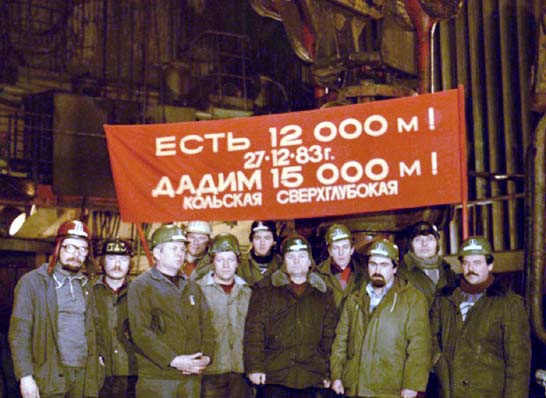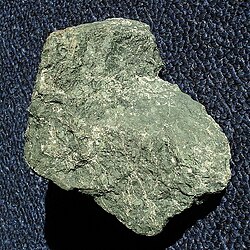The Kola Superdeep Borehole is the deepest artificial point on Earth. It is located in the Pechengsky District, Murmansk Oblast, Russia.
In 1970, the Soviet Union began drilling the Kola Superdeep Borehole SG-3. The goal was to drill as deep as possible into the Earth's crust. After 20 years of drilling, they had reached a depth of 12,262 metres
On May 24, 1970, the Soviet Union’s Sverdlovsk-19 drilling rig reached a depth of 12,262 meters (40,230 feet), making it the world’s deepest hole. But this was just the beginning. The Kola Superdeep Borehole would eventually reach a final depth of 12,362 meters (40,502 feet), making it the deepest manmade hole on Earth. The Kola Superdeep Borehole is located in Murmansk Oblast, Russia. It was created by the Soviet Union’s Academy of Sciences in an attempt to drill as deep as possible into the Earth’s crust. The project began in 1970 and ended in 1994. During that time, three different drilling rigs were used to reach a final depth of 12,362 meters (40,502 feet). The borehole is only 9 centimeters (3.5 inches) in diameter and is lined with a steel casing. It is estimated that the total length of the borehole is about twice the depth – meaning it extends for at least 24 kilometers (15 miles) into the Earth’s crust. Despite its depth, the temperature within the Kola Superdeep Borehole
30 ft). The Kola Superdeep Borehole is the deepest man made hole in the world. It's also one of the most mysterious. No one knows why the Russians stopped drilling or what they found down there.
ole was drilled by the Soviet Union in the 1970s and is still the deepest artificial point on Earth. The borehole was drilled for scientific research and is named after the Kola Peninsula, where it is located. The drilling project started in 1970 and reached a depth of 12,262 metres (40,230 ft) in 1980. It was then deepened to 12,345 metres (40,502 ft) in 1984. The borehole has been used for studies of the Earth's
In the 1970s, the Soviet Union began drilling
In 1970, the Soviet Union began drilling a hole deeper than any other that had ever been made by man. They were looking for evidence of what the Earth's crust was like millions of years ago. But what they found instead was something even more mysterious. The Kola Superdeep Borehole SG-3 is still the deepest manmade hole in the world, and it holds many secrets. In this blog post, we'll explore some of the strange things that have been found in the Kola Superdeep Borehole SG-3, and what they could mean for our understanding of the Earth's history.
ng a hole in the Earth that would become the world’s deepest manmade hole. The Kola Superdeep Borehole, as it’s called, is still the deepest hole ever made by humans, and it’s more than 7 miles deep. The drilling project was a joint effort between the USSR and the United States, and it was meant to be a scientific endeavor to study the Earth’s crust. But when the Soviets began drilling, they found something unexpected: mineral deposits that were far older than anything they had ever seen before. The Kola Superdeep Borehole is a fascinating example of human achievement—and it’s also a reminder of how much we have left to explore about our planet.
crust and mantle. In particular, scientists have been able to study seismic activity at depths not accessible by other means.
Why the deepest man made hole was dug?
The Kola Superdeep Borehole SG-3 was dug for a variety of reasons. The main reason was to study the Earth's crust and mantle. The borehole also provided scientists
The hole was drilled over a period of nearly twenty years in an attempt to study the Earth's crust. It is located in Russia's Kola Peninsula, which juts out into the Arctic Ocean. The borehole is more than seven miles deep, and at its bottom, temperatures reach nearly 180 degrees Fahrenheit.
 |
| Real picture of Kola Superdeep |
The drilling began in 1970 and continued until 1994. During that time, Soviet geologists chipped away at the rock around the clock in shifts, eventually reaching a depth of 40,000 feet. They were hoping to find evidence of a "super-continent" called Pangaea that is thought to have existed before the Earth's current land masses broke apart.
Although they did not find evidence of Pangaea, the drillers did discover something else: a layer of granite that is much harder than the surrounding rock. This discovery has led scientists to believe that the Earth's crust is thinner than they had previously thought.
with an opportunity to study the Earth's deep oceans, as well as the hot rocks that make up the Earth's core.
What Russia got from it?
Russia got a lot from the Kola Superdeep Borehole SG-. We learned about the Earth's crust, the mantle, and the core. We also learned about the composition of the Earth's layers and how they interact with each other. Finally, we gained new insight into the processes that occur deep within the Earth.
When I first heard about the Kola Superdeep Borehole, I was really curious about what they had found. I was also curious about how deep the hole went and what they had to do to get there. After reading this article, I learned a lot about the Earth's layers and how they interact with each other. I also found out that the Kola Superdeep Borehole is the deepest man-made hole in the world.immediately fascinated by its story. I knew that it was the deepest man-made hole in the world, but I didn't know much else about it. After doing some research, I found out that the borehole is located in Russia's Kola Peninsula, and that it was drilled in the 1970s as part of a scientific experiment to study the Earth's crust.
I also learned that the borehole is still active today, and that scientists have used it to collect samples of rocks and minerals from depths never before reached by humans. These samples have helped us to better understand the composition of our planet and the processes that occur deep within its crust.
Overall, I found the Kola Superdeep Borehole to be a fascinating example of human achievement, and an important contribution to our understanding of our planet.
Noise Of the Hell
There are a few theories as to why Russia closed the Kola Superdeep Borehole. One theory is that they discovered something they couldn't explain and decided it was best to close it off. Another theory is that the costs of running the operation were becoming too high. Whatever the reason, Russia has kept mum about why they decided to close the hole.
Why Russia closed it?
In 2008, the Kola Superdeep Borehole was closed after almost 30 years of operation. The decision to close the borehole was made for a number of reasons, including:
1. The high cost of maintaining and operating the borehole.
2. The borehole had reached its maximum depth and was no longer providing useful data. There was concern that the borehole could collapse, causing an environmental disaster.The increased risk of ground instability and subsidence associated with continued operations.
3. The need to focus on other priorities, such as developing new drilling technologies and exploring other deep geological formation.





